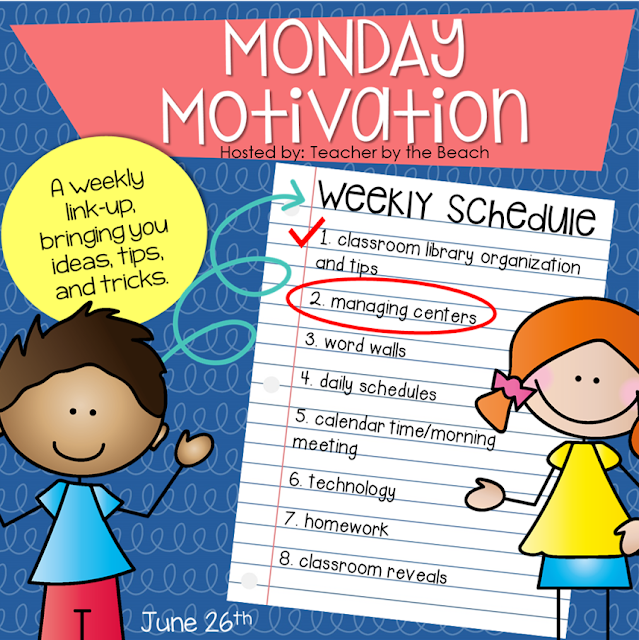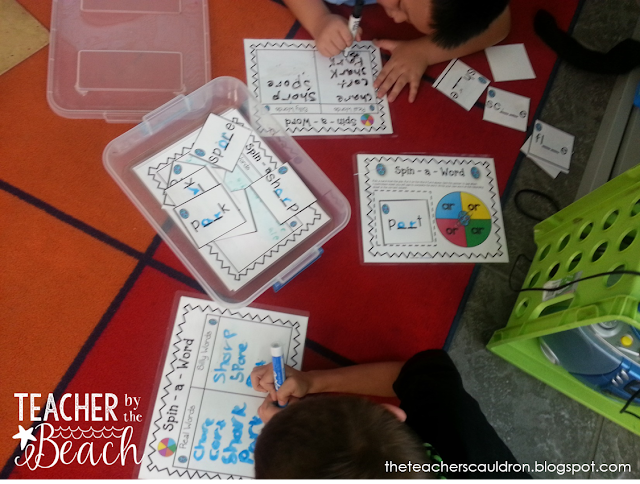This week's Motivation Monday is all about how I manage my centers!
If you missed last week's you can read about it here:
Ok. So Guided Reading. Centers. These two things are a HUGE part of my teaching.
As I'm sure they are yours, too.
Everyone does them differently.
But I'd like to share with you what I do in mine.
They are my FAVORITE part of my day. I could do this all. day. long.
I'm not sure where to begin because my mind starts in about 4 different areas all at once when I want to start explaining. I have done a few posts on centers {
HERE} and {
HERE}. I've also done some Guided Reading posts {
HERE} and {
HERE}
First, let me show you how I do the rotations.
I made a template in Powerpoint and I put each slide on a timer on the slides so that I just push play and the whole thing runs without me having to get up and do anything!
That particular year, I had 4 rotations.... Journal, Centers, Teacher, and Seatwork.
I now have 5 centers - Teacher, Read to Self, Journal, Center, and Seatwork...it changes with each group of kids, because each class is different and each year our schedule is different as to how much time I have for centers. Ideally, I'd LOVE a 2 hour block for reading...including whole group and small group, BUT, that doesn't always happen.
Every time the slides change, the wheel just turns. It works perfectly!
In between each activity slide, I have a "Clean Up!" slide that lasts for 30 seconds.
You can check out the Small Group Rotation Powerpoint {
HERE}
Ok, so I think I'll go to the Center Menu next.. I can kind of kill 2 birds with 2 stones with this one.
So, the amount of centers I do changes from year to year, and sometimes I change my mind in the middle of the year - like I did last year.
I have done 10 centers on a menu... which I did 2 centers in one day. I posted about how I did that on {
THIS} and {
THIS} blogpost.
And that's how I started my year off last year.
But then, I decided to change my way after I got back from my maternity leave last year...and that's when I went to the powerpoint rotation and only 5 centers for the week and a Journal on the rotation for each day.
Here is what my menus look like for that set up:
And now I currently have 8 centers for each rotation week, that way I really only need to come up with centers 2x a month. It's a game changer. Really. We don't start on Monday and end on Friday...and I don't worry about staying on track for the week... if we have to miss a day because of a school event, we just resume our center the next day...
Each center bucket is correlated with the number on the menu and then what the Journal topic is for each day. I label them Day 1, 2.... because I don't always start on Monday and end on Friday. I actually DON'T like starting on a Monday. It makes for a stressful Monday and Friday. lol.
These are the buckets that I have labeled to match the menu.
For seatwork, I pull a lot of activities from my {
phonics packs}. I have one for each phonics skill. I have a love for phonics. haha! That's normally what I do - phonics, for seatwork.
But sometimes my seatwork isn't actually SEATwork. We do a lot of walking around the room too!
One of my staple centers is Listening centers.
And some kind of word work.
I also have a sentence writing one...whether it's writing a complete sentence or stretching a sentence or unscrambling a sentence.
Then there's the journal writing part of the rotation. I really believe that to become better writers, you have to practice...just like reading. So I like to have them do journal responses. I try to make the "prompts" based around what we've been reading or learning about in class.
I have some "fancy shmancy" journal covers you can download for free - and you can see how I set them up for the year {
HERE}.
When we're ALL done with our rotations for the day, the kids put everything on their desk I need to see... their seatwork should be filed and I need to see their center and their journal writing. I check off thier menus...just a check mark if it's finished, or a circle if it's not. If they finished but need to fix a lot of it, then I put "fix" in the box and give them the week to fix it on their own time.
After Day 5, I collect all the centers and staple them to their menus and give them a grade...the grade is just for completion and it documents if they stay on task and/or have trouble with certain skills.
Now, let's talk Guided Reading.
Once I have them leveled, I put them on my Levels at a Glance page in my binder. I put all the similar levels together and then box them in with different color crayons to create my groups.
I make a new one each month. I don't always assess my AGL kids, but my OGL and my BGL I want to see if they're moving, so I do test them each month.
I like to make a quick look for me to see without getting out my binder... like if one of my kids asks what level books he can get for baggie books...or if I'm looking in my Reading A-Z files and I don't want to get out my binder, I just look over at this. I put it away when we have conferences, of course.
I also like to do a quick Dibels assessment.
I put them in the ORF data sheet as one of 4 different types of readers:
fast/right
fast/wrong
slow/right
slow/wrong
Depending on the reasoning behind the kids that are either slow or wrong, then I will work with them on their fluency.
Ok, so the big question.
What do I use for my guided reading books since I don't use the reading series?
I like to use
Reading A-Z. I really like this better than using the series' leveled readers because I can match the levels better to my students...AND it's how I can get my themes to all tie in together....and BONUS!! It's how I hit a lot of my science and social studies content, too!
Yes, you have to print the books. BUT, I don't let them write in them and I keep them for the following years. And if they lose them when I send them home? No biggie! I can print up a new one!
Now, aside from using Reading A-Z, I also have a slew of other things I like to use during my small groups. I've posted about it before {
HERE}. But here are a few pictures....
I've been using them forever!!
I mean... this picture is about 4 years old..and my computer crashed so I don't have the original to fix it, but you get the point! ha!
You can use counters to count the sounds or you can write in the letters for the sounds. I always have them count the sounds before they write them.
Whisper phones - I did a DIY post on those {
HERE}
I also love EZ readers! I have a few different kinds that I've gotten from Really Good Stuff.
Another one of my favorite things I use are these little foam letters. I love them. They are smooth on one side and bumpy on the other side...so it's easier for them to know which way the "a" goes or the other easily mixed up letters.
I pick a mystery word out of the book we are reading and then I make words out of that word and we practice phonics skills.
The students use the little foam letters and I use my own letters in a small pocket chart.
I do Making Words with my kids every week. This is one of the activities in my
Guided Reading pack. There's a teacher planner page that really helps you to plan it out so all the words flow, and then there are student extensions like this page.
Another thing I really like to focus on is Fluency. Obviously, not all of my groups work with fluency, if they are below grade level on their running records, then we focus on phonics and decoding skills, THEN we can work on fluency.
I've posted about Peer to Peer fluency {
HERE}
Most of all these resources can be found in my
Guided Reading Pack, including some sample lesson plan templates.
NOW, for math centers??
Every year is different. For some reason my math block just doesn't ever seem to flow as well as my reading block - I'm not sure why....
Sometimes I run math centers a lot like I run Reading centers, using the screen to tell them where to go. Other years I do it where after I teach whole group, I do an informal assessment to see who needs more teaching for the skill. If they need reteaching, I'll keep them with me at my table or on the floor (Depending on the size of the group), and the others will go do their journal/seatwork and then to a center....sometimes kids don't go to centers that day if they needed more teaching time on the skill that day.
So since not everyone goes to a center, I don't use a menu for math centers. I use a different method for them to know if they've been to that center. I have these math center cover sheets that I have taped to the tops of the boxes. They are laminated and when kids do that center, I take a sharpie and cross off their names. (You know you can take off Sharpie with a dry erase marker, right!?). That way when they go to choose which center they want to do, they can look at the cover sheet to see if their name is crossed off. If it is, then to the next center the go! (I have since switched to using numbers instead of names so I don't have to remake these each year!)
Inside the box, I keep everything they will need to do that center (just like the reading centers). For this one, they'll need die and counters...or chips as some of my kids like to call them.
I hope this post helps to give you some ideas on how to manage or set up your guided reading! It was a lot to take in. Let me know if you need any clarification on anything!
Check out how other bloggers set up their small groups!
Please feel free to link up! Just make sure you link back to this blogpost in your post. You can link up an old or new post.















































































